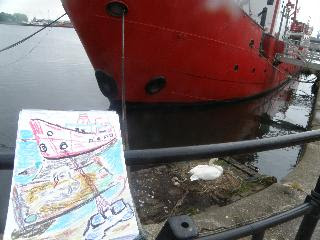Some observations on Migration and building Nest .... Competition for Space!

My support work introduced me to a new area of water in March ... that of Atlantic Wharf an area of water that formally formed part of the Cardiff docks but now forms an inland water flanked by housing and offices on three sides and backed by the steel works and a trunk road on the other.
I was amazed to find a pair of swans nesting on this water way back in March a good month earlier than swans that ii have followed on Roath lake in previous years.
I was led to create the above impression on a very cold day at the end of March when the wind was bracing and certainly in South Wales we experienced hail and snow showers. It was very comforting to realise that the swifts had arrived and were flying on the wind above the water in pursuit of insects. It gave hope that eventually warmer weather would come too and that the swifts were here despite the cold!!
There are many other wetland birds on the wharf ... how many can you spot? It makes an interesting comparison to Roath Lake and one is left wondering if the pair of swans were nesting early as there was no competition for territories and nesting spots?
Competition observations on Roath Lake

Some of the earliest birds to nest round the circumference of the lake are the Coots who seem to build nests out on every possible piece of sheltered water and even in this case have built their nest up the bank on the islands.
This is not the usual spot for coots normally forming nests in the water formed of twigs and undergrowth. This move to a bank location one can only assume has come about as a result of the competition of nesting sites and the relative safety the island location offers to predators.
Swan Action
In recent years it has been remarkable to see some of the creative attempts that Mute Swans in Roath Park have made to secure nesting sites within the park.
I photographed a pair of swans in March 2009 taking a particular interest in a patch of daffodils in the park close to the lake
At the end of April 2010 I was amazed to discover a pair of swans had built a nest from the remains of the daffodil heads.
The swans must have actually broken off the stems to create their nest captured in my painting impression below.


The pair were still successfully sitting on their two eggs as I write this.
It has to be said that there is any number of other sites that have not been so successful!

Could this be young couples (3-4 years old)
making their first inroads at nesting and breeding?
The nesting site on the right has been attempted in both the last two seasons. In 2009 a egg was even laid before the nest was abandoned.
It can only be hoped that the nesting pair among the daffodils will see success!
Has anyone else seen this sort of behaviour among possibly juvenile swans possibly experimenting at breeding?

It is also amazing to realise that our own favourite birds are sharing their waters with birds that still have to migrate. It is not often that a tufted duck is seen on the bank , could it have been saving energy as it contemplates flying to its probable destination in Eastern Europe?
The Icelandic Volcanic Ash Cloud
The Wildfowl and Wetlands Trust do much work tracking the movements of both the Bewick Swan which migrates NE to Northern Russia to breed.
while the Whopper Swan flies NW to Iceland.
News on the WWT website at least one of the Whopper Swans with a tracking device had lost its signal as the Volcanic ash swept across our upper atmosphere affecting our airspace and air travel.
Pictured the map on the WWT website that can be followed to see the progress of the migrating Whopper Swan.
 Each time the pen rose of her nest to turn her eggs it became clear that two of the eggs were showing signs of cracking, the little fluff of flesh inside was beginning to peck its way out.
Each time the pen rose of her nest to turn her eggs it became clear that two of the eggs were showing signs of cracking, the little fluff of flesh inside was beginning to peck its way out.




 Even the first born appears to give a helping nudge with his beak!
Even the first born appears to give a helping nudge with his beak!



























